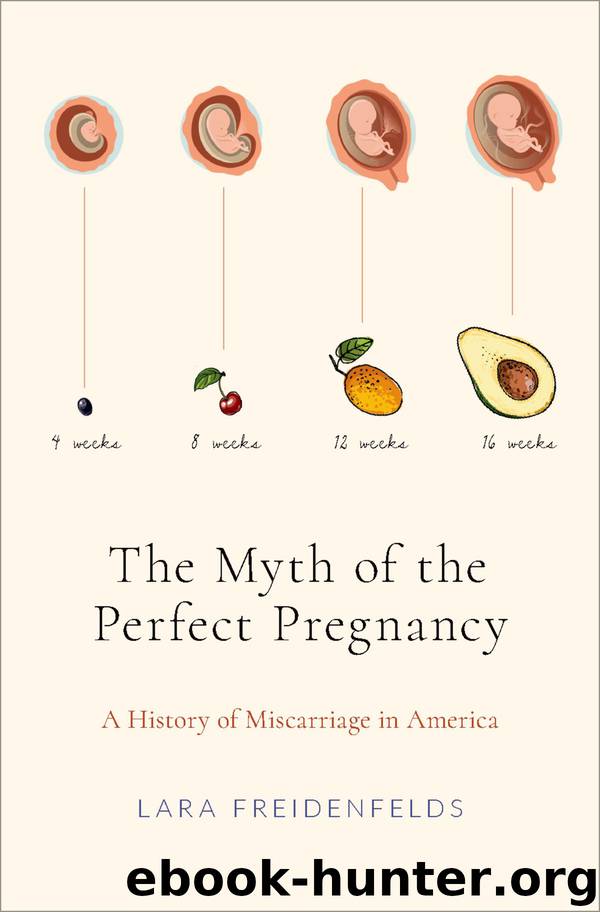The Myth of the Perfect Pregnancy by Lara Freidenfelds

Author:Lara Freidenfelds
Language: eng
Format: epub, azw3
Publisher: Oxford University Press
Published: 2019-01-15T00:00:00+00:00
Twentieth-Century Parents-to-be Enter the Consumer Age
At the turn of the twentieth century, an American culture of consumption bloomed rapidly and, with it, the market for babies’ and children’s goods flourished. It was in the twentieth century that children became an excuse to shop. Continuing industrialization and improved transport brought a panoply of consumer goods to Americans everywhere. City dwellers shopped in new department stores, while the Sears catalog and the Wells Fargo wagon served the countryside. Retailers targeted a range of new customers, from the established middle class to working parents who scrimped and saved to buy a special outfit or two and a modern, hygienic bottle and nipple for a new baby.13
Advertising and selling grew more sophisticated. Advertising developed from simple lists of available products and prices to its own genre of persuasive literature. Marketing and sales developed into full-blown professions with an array of specialized trade journals.
As historian Gary Cross has documented, advertisers and marketers cannily observed that Americans had come to treasure the perceived innocence of their children and helped create a vision of “wondrous innocence.” Parents could re-live an idyllic childhood through their children’s eyes by sharing with them new and wonderful toys and other material goods. And they could justify it as morally acceptable because it was pleasurable consumption on behalf of their beloved children, rather than money spent on themselves.14
A new baby increasingly seemed to require a mountain of purchases, and retailers gradually learned how to make the buying process easy, even fun, for expecting parents. In the 1920s, department stores began experimenting with “infant” departments, innovatively organizing goods based on the customer’s identity, rather than on product categories such as shoes or toiletries. The idea was novel enough in 1921 for the New York Times’ business pages to feature an extended interview with Mrs. E. Gilman, a manager of wholesale infants’ and children’s wear with the Bush Company in New York City. She told the reporter, “If there is anything that appeals to the prospective mother when she goes to shop . . . it is being able to find nearly everything she wants and needs assembled in a single part of the store. She does not want to have to go to the fabric section to buy some baby muslins and then have to go to the drug sundries department in some other part of the store to get a bath thermometer. I am a mother, and I know from experience.”
Mrs. Gilman coached hundreds of department stores in this type of reorganization. She advocated putting the baby linens with the cribs and assembling “maternity baskets” and “obstetrical baskets” to prepare for home births, with products recommended by prominent local physicians. She included toys and cute dresses, along with clothes, furniture, and toiletries. The reporter seemed especially struck by Gilman’s suggestion that maternity corsets and gowns be stocked in the infants department as well.15
Hundreds of product lines from all around the store were to be gathered in the infants department to give “prospective
Download
The Myth of the Perfect Pregnancy by Lara Freidenfelds.azw3
This site does not store any files on its server. We only index and link to content provided by other sites. Please contact the content providers to delete copyright contents if any and email us, we'll remove relevant links or contents immediately.
Periodization Training for Sports by Tudor Bompa(8170)
Why We Sleep: Unlocking the Power of Sleep and Dreams by Matthew Walker(6618)
Paper Towns by Green John(5091)
The Immortal Life of Henrietta Lacks by Rebecca Skloot(4526)
The Sports Rules Book by Human Kinetics(4294)
Dynamic Alignment Through Imagery by Eric Franklin(4118)
ACSM's Complete Guide to Fitness & Health by ACSM(3989)
Kaplan MCAT Organic Chemistry Review: Created for MCAT 2015 (Kaplan Test Prep) by Kaplan(3940)
Introduction to Kinesiology by Shirl J. Hoffman(3726)
Livewired by David Eagleman(3684)
The Death of the Heart by Elizabeth Bowen(3552)
The River of Consciousness by Oliver Sacks(3541)
Alchemy and Alchemists by C. J. S. Thompson(3451)
Bad Pharma by Ben Goldacre(3357)
Descartes' Error by Antonio Damasio(3230)
The Emperor of All Maladies: A Biography of Cancer by Siddhartha Mukherjee(3068)
The Gene: An Intimate History by Siddhartha Mukherjee(3048)
The Fate of Rome: Climate, Disease, and the End of an Empire (The Princeton History of the Ancient World) by Kyle Harper(3003)
Kaplan MCAT Behavioral Sciences Review: Created for MCAT 2015 (Kaplan Test Prep) by Kaplan(2940)
